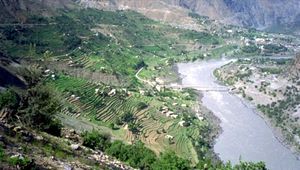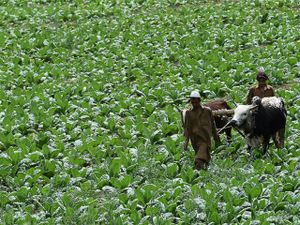Course:FRST270/Wiki Projects/Water Rights in North India's Jammur and Kashmir State India
Water Rights in North India's Jammur and Kashmir State and Pakistan
Jonathan Kwok

The Indus river is a major source of resources for the villages that are situated along the river, especially near the mouth of the river when agriculture is optimal. Water from the Himalayas are a major resource since it meets basic living needs, however the access to water is threatened by hydro-electric dam projects in Jammu and Kashmir, North India. Smaller hydro projects already have had negative effects on farmers in Pakistan who are located downriver and depend on the river’s high water table for agriculture, yet India is intended to pursue larger projects since Jammu and Kashmir are economically limited in resources[1]. Projects have been delayed from the enactment of the Indus Water Treaty that was agreed on 1960 between India and Pakistan, after the 1947 partition of British ruling. At present, deals between the countries are still being negotiated[2].
River Description and History
The River is one of the largest rivers in the world, stretching 3,200 kilometers[3]. The drainage basin begins the at the Himalayas in Tibet, China, then passes through North India’s state Jammu Kashmir. The mouth of the river ends at the Arabian sea in the Southern Singh province of Pakistan, which is also home to the largest arid mangrove ecosystem. The total drainage is approximately 1,165,000 square kilometers, and the river’s annual flow is 243 cubic kilometers.
During British colonial rule, the lands were changed and optimized for production by utilising the Indus river system. At that time, the canal systems for the river was known to provide Punjab the most extensive irrigation system in the world[4]. After the partition of 1947, a border was drawn to what is now Pakistan and India. Disputes of tile rights to the river arose during times of droughts. Even though agreements and treaties have mitigated conflicts, debates on agreement and treaty claims are still discussed.

Tenure arrangements
Standstill Agreement 1947
The autumn of 1947, the monsoon flows receded thus limiting water access. This caused water-rights disputes to escalate. As a fast-temporary solution, chief engineers of West and East Punjab have met and signed a Standstill Agreement on December 18th 1947[5]. This agreement froze water allocations allowing full water discharges on the Upper Bari Doab Canal, the Dipalore Canal, and the Bahawalpur Canal systems. The agreement expired on March 31st 1948 and was left open for discussion, but was left absent. India acquired legal right to certain parts of the river bordering Pakistan, to which India discontinued delivery of water from areas on April 1st 1948.
Indus Water Treaty
In 1951 David Lilienthal visited the conflicting countries and analysed the situation and suggested joint control to solve affairs[6]. The world bank then recognized Lilienthal’s suggestion and offer the negotiation to help resolve the conflict. Suggestions included: the Indus Basin must be developed as a unit-designed built and operated similarly to a system in the United States, International financing will be arranged by the World Bank, and representatives from both countries will be included. After many additional proposals and reviews, the Indus Water Treaty was agreed on September 19th 1960.
Hydro Dams

Pakistan has claimed that India has failed to uphold the Indus Water Treaty due to hydro electric projects. As India prepares for construction, many rivers that flow through Pakistan will be diverted. Dams such as the planned Kishangana Project 2007 will divert water from the Neelum river to Wullar Lake to generate electricity. Data shows that water diverted from the river including the 8 month long dry season will have huge impact on the agricultural regions in the Azad Kashmir region of Pakistan [7]. The Azad Kashmir region is one of the many areas that will be affected downstream.
As a response, Pakistan has appealed to International Court of Arbitration (ICA) to prevent India from continuing any future constructions or projects until further notice. The ICA stated that India shall not continue with the construction or any permanent works on or above the project that may inhibit the natural flow of the river channel[8]. However, India has further denied claims of tampering of the waterbed nor any storage construction. The treaty also states that Indian is permitted project on western rivers, therefore projects themselves cannot be in violation of the treaty as long if they do not deviate from certain areas[9]. The ICA then commented that India may continue with the hydro electric project as long as the riverbed surface is not touched. This means coffer dams, bypass tunneling, and construction under the river bed can be allowed. Construction was allowed to start near the end of 2012 and beginning of 2013. Even with environmental assessments, India does not usually forth come in sharing data and avoids announcing plans to projects ahead of time, causing suspicion[10].
Affected Stakeholders

Pakistan's farmers
As of now, Pakistan relies on the largest contiguous irrigation system in the world. There are 3 major reservoirs, 12 inter-river link canals, and 45 major irrigation canal commands; irrigated lands produce 90 percent of the country’s agriculture[11]. Other than agriculture, villagers near the river need the water for washing, bathing, and other sanitary reasons. In the lower riparian states of Pakistan, many farmers have shown great concern to the hegemonic policies upstream the Indus river. Many of the local ecosystem will be negatively affected due to the change in water flow, thus creating unpredictability in non-timber forest products available[12]. The villagers have also claimed that the Indian government has openly threatened to stop the flow of the Indus river[13]. Due to the demand of ensuring on-going supply of water, farmer leader mentioned that growers will have no choice but to amass in the diplomatic enclave in the main capital and a memorandum will be shown to the UN, and the World Bank forcibly[14].
Interested Outside Stakeholders
The World Bank
A representative of the World Bank, David E. Lilienthal, visited the region of conflict and recommended the World Bank to facilitate the Indus river negotiation, which both countries agreed. The World Bank offered its offices and facilitation of the mediation in 1952 which led to the Indus Water Treaty in 1960[15]. The bank’s interest is in its economic value as well its political influence within the treaty. This power is shown in the annex as it states that the bank’s president can nominate a person to facilitate the arbitration’s umpire for when India or Pakistan fail to agree on terms[16]. This influence can attract the power of abuse.
Government of India
The Jammu and Kashmir state of India are located in a region of limited resource (Himalayan region)(book ref). Its economy is relied mostly on tourism, but there is potential of economical expansion. The northern state has been pursuing hydro-electric projects for many years, but is interrupted from Pakistan’s claim of violating the treaty. Not only there are political restrictions to the projects, there are environmental drawbacks. Building “large hydro projects” require high attention to policies, environmental issues, and social issues. Under the treaty, India is allowed to pursue “small hydro projects” which are exempt from the EIA (environment impact assessment), EMP (environment management plan), and the SIA (Social impact assessment)[17].
Discussion
Unfortunately, this is not a simple one-sided conflict. Each country’s intention is for the benefit for itself and not to purposefully harm each other, and the Indus river is a necessity for both parties. North India’s state are supposed to economically benefit from the dams however at a cost of negative externalities: environmental and social damage[18]. Dam constructions cause major river bed and landscape degradation and interferes aquatic life, which can further degrade the landscape downstream. The reduce in water flow will also negatively affect Pakistan’s farmers as the experience of drought including the limited water availability will be harsher.
Recommendations
Transferring Benefits
As population grows and resources become a luxury, the tension between the warring countries will expedite. North India's pursue of energy and economical growth will deteriorate Pakistan's agricultural economy, and full granted flow of the Indus river to Pakistan will limit North India's economy and energy production. If both countries continue to pursue their own interest, both will be affected like a double-edged blade. From this case study, what can be recommend is to allow one party to fully purse its interests, as well as paying gratitude to the other party for allowing full access to the river. If India is granted its permission to pursue its hydro-electric projects, India should pay Pakistan in taxes or in resources as gratitude since agriculture will be limited from the dams. If India is not given permission to pursue its hydro-electric projects, that would mean Pakistan would have full access to the river and therefore optimizing agricultural production. In that case, Pakistan should pay India in taxes or agricultural resources in gratitude since North India is already limited in resources. These gratitude payments will be facilitated by the World Bank as a neutral party.
References
- ↑ Sharma, A. K., & Thakur, N. (2015). Resource potential and development of small hydro power projects in Jammu and Kashmir in the western Himalayan region: India. Renewable and Sustainable Energy Reviews, 52, 1354-1368. doi:10.1016/j.rser.2015.08.024
- ↑ India, Pakistan talks fail to end deadlock on Indus water dispute. (2017). Retrieved October 21, 2017, from https://economictimes.indiatimes.com/news/politics-and-nation/india-pakistan-hold-talks-on-indus-waters-treaty/articleshow/60526137.cms
- ↑ Lodrick, D. O., & Ahmad, N. (2016). Indus River. Retrieved from https://www.britannica.com/place/Indus-River
- ↑ Nazakat Ali, R., Faiz-ur-Rehman, & Mahmood-ur-RehmanWani. (2015). Indus Water Treaty between Pakistan and India: From Conciliation to Confrontation. Dialogue (1819-6462), 10(2), 166-181.
- ↑ Nazakat Ali, R., Faiz-ur-Rehman, & Mahmood-ur-RehmanWani. (2015). Indus Water Treaty between Pakistan and India: From Conciliation to Confrontation. Dialogue (1819-6462), 10(2), 166-181.
- ↑ Nazakat Ali, R., Faiz-ur-Rehman, & Mahmood-ur-RehmanWani. (2015). Indus Water Treaty between Pakistan and India: From Conciliation to Confrontation. Dialogue (1819-6462), 10(2), 166-181.
- ↑ Khan, M. R. (2013). Crucial Water Issues between Pakistan and India, CBMs, and the Role of Media. South Asian Studies (1026-678X), 28(1), 213-221
- ↑ Khan, M. R. (2013). Crucial Water Issues between Pakistan and India, CBMs, and the Role of Media. South Asian Studies (1026-678X), 28(1), 213-221
- ↑ World Bank Group US. 1960. "Indus Water Treaty 1960." Retrieved from https://siteresources.worldbank.org/INTSOUTHASIA/Resources/223497-1105737253588/IndusWatersTreaty1960.pdf
- ↑ Nabeel, F. (2017). How India and Pakistan are competing over the mighty Indus river. Retrieved from http://www.independent.co.uk/environment/how-india-and-pakistan-are-competing-over-the-mighty-indus-river-a7769506.html
- ↑ Yu, W. H., Yang, Y., Savitsky, A., Alford, D., Brown, C., Wescaot, J., . . . Robinson, S. (2013). The Indus Basin of Pakistan: the impacts of climate risks on water and agriculture. Washington, D.C.: The World Bank.
- ↑ Yu, W. H., Yang, Y., Savitsky, A., Alford, D., Brown, C., Wescaot, J., . . . Robinson, S. (2013). The Indus Basin of Pakistan: the impacts of climate risks on water and agriculture. Washington, D.C.: The World Bank.
- ↑ Indus Water Treaty: Farmers say Indian policies leaving Pakistan high and dry. (2017). Retrieved from https://tribune.com.pk/story/1403983/indus-water-treaty-farmers-say-indian-policies-leaving-pakistan-high-dry/
- ↑ Indus Water Treaty: Farmers say Indian policies leaving Pakistan high and dry. (2017). Retrieved from https://tribune.com.pk/story/1403983/indus-water-treaty-farmers-say-indian-policies-leaving-pakistan-high-dry/
- ↑ Patel, B. N. (2017). Why does World Bank want to broker Indus water talks between India and Pakistan. The Indian Express. Retrieved from http://indianexpress.com/article/opinion/why-does-world-bank-want-to-broker-indus-water-treaty-talks-between-india-and-pakistan-846306/
- ↑ Patel, B. N. (2017). Why does World Bank want to broker Indus water talks between India and Pakistan. The Indian Express. Retrieved from http://indianexpress.com/article/opinion/why-does-world-bank-want-to-broker-indus-water-treaty-talks-between-india-and-pakistan-846306/
- ↑ Sharma, A. K., & Thakur, N. (2015). Resource potential and development of small hydro power projects in Jammu and Kashmir in the western Himalayan region: India. Renewable and Sustainable Energy Reviews, 52, 1354-1368. doi:10.1016/j.rser.2015.08.024
- ↑ Yu, W. H., Yang, Y., Savitsky, A., Alford, D., Brown, C., Wescaot, J., . . . Robinson, S. (2013). The Indus Basin of Pakistan: the impacts of climate risks on water and agriculture. Washington, D.C.: The World Bank.
| This conservation resource was created by Course:FRST270. |
